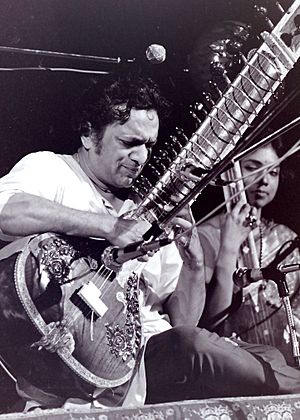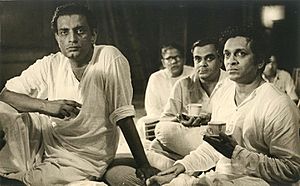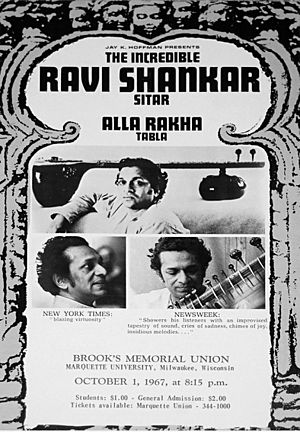Ravi Shankar facts for kids
Quick facts for kids
Pandit
Ravi Shankar
|
|
|---|---|

Shankar performing in 1969
|
|
| Born |
Ravindra Shankar Chowdhury
7 April 1920 Benares, Benares State, British India
|
| Died | 11 December 2012 (aged 92) San Diego, California, US
|
| Occupation |
|
| Member of Parliament, Rajya Sabha | |
| In office 12 May 1986 – 11 May 1992 |
|
| Musical career | |
| Genres | Indian classical music |
| Instruments | |
| Years active | 1930–2012 |
| Labels |
|
| Associated acts |
|
Ravi Shankar (born Robindro Shaunkor Chowdhury; 7 April 1920 – 11 December 2012) was a famous Indian sitar player and composer. A sitar virtuoso, meaning a highly skilled musician, he became known worldwide for North Indian classical music in the second half of the 20th century. He inspired many musicians in India and around the globe. In 1999, Shankar received India's highest civilian award, the Bharat Ratna.
Shankar was born into a family in India. When he was young, he toured India and Europe as a dancer with his brother Uday Shankar's dance group. In 1938, he stopped dancing to learn how to play the sitar from the court musician Allauddin Khan. After finishing his studies in 1944, Shankar became a composer. He created music for the famous Apu Trilogy films by Satyajit Ray. He also worked as the music director for All India Radio in New Delhi from 1949 to 1956.
In 1956, Shankar started touring Europe and the Americas. He played Indian classical music and helped make it popular in the 1960s. He did this by teaching, performing, and working with violinist Yehudi Menuhin and Beatles guitarist George Harrison. His influence on Harrison helped bring Indian instruments into Western pop music in the late 1960s. Shankar also wrote music for sitar and orchestra, blending Indian and Western styles. He toured the world in the 1970s and 1980s. From 1986 to 1992, he was a member of the Rajya Sabha, which is like the upper house of the Parliament of India. He continued to perform until he passed away.
Contents
Early Life and Musical Beginnings
Ravi Shankar was born on 7 April 1920 in Benares, India. He was the youngest of seven brothers in a Bengali family. His father, Shyam Shankar Chowdhury, was a lawyer and scholar. He worked in London and later became a prime minister in an Indian state. Ravi's mother, Hemangini Devi, raised him in Benares.
Ravi shortened his first name, Ravindra, to Ravi, which means "sun." His older brother, Uday Shankar, became a famous dancer and choreographer.
When he was 10, Ravi moved to Paris with his brother Uday's dance group. By age 13, he was part of the group. He learned to dance and play different Indian instruments. The group traveled across Europe and the United States in the early 1930s. During this time, Ravi learned French and discovered Western classical music, jazz, and movies.
In 1934, Ravi heard Allauddin Khan, a great musician, play in Kolkata. Uday convinced the Maharaja of Maihar to let Khan join their group for a European tour. Khan sometimes taught Ravi during the tour. Khan offered to teach Ravi seriously if he stopped touring and came to live in Maihar.
Developing a Musical Career in India

After his European tour, Shankar decided to become a serious musician. In 1938, he moved to Maihar to study Indian classical music with Allauddin Khan. He lived with Khan's family, following the traditional gurukul system, where students live with their teacher. Khan was a very strict teacher. Shankar learned to play the sitar and surbahar. He also learned about ragas (melodic frameworks) and different musical styles. He often studied with Khan's children, Ali Akbar Khan and Annapurna Devi.
Shankar first performed publicly on the sitar in December 1939. His first performance was a jugalbandi (duet) with Ali Akbar Khan, who played the sarod.
Shankar finished his training in 1944. He moved to Mumbai and joined the Indian People's Theatre Association. He composed music for their ballets in 1945 and 1946. At 25, Shankar re-arranged the music for the popular song "Sare Jahan Se Achcha". From 1949 to 1956, he worked as a music director for All India Radio (AIR) in New Delhi. Shankar started the Indian National Orchestra at AIR and wrote music for it. He combined Western and classical Indian instruments in his compositions. In the mid-1950s, he composed the music for the famous Apu Trilogy films by Satyajit Ray. He also directed music for several Hindi movies.
Becoming an International Star
In 1952, the director of AIR Delhi, V. K. Narayana Menon, introduced the famous Western violinist Yehudi Menuhin to Shankar. Shankar had performed in the Soviet Union in 1954. In 1955, Menuhin invited Shankar to perform in New York City. This was a demonstration of Indian classical music.
Shankar heard about how well Khan's performances were received in the West. So, in 1956, he left AIR to tour the United Kingdom, Germany, and the United States. He played for smaller audiences and taught them about Indian music. He even included ragas from South Indian Carnatic music in his shows. He recorded his first album, Three Ragas, in London in 1956.
In 1958, Shankar took part in the 10th anniversary celebrations of the United Nations and a UNESCO music festival in Paris. From 1961, he toured Europe, the United States, and Australia. He became the first Indian to compose music for non-Indian films. In 1962, Shankar founded the Kinnara School of Music in Mumbai.
Shankar became friends with Richard Bock, who started World Pacific Records. He recorded many of his albums in the 1950s and 1960s for Bock's label. The band The Byrds recorded in the same studio and heard Shankar's music. This inspired them to use some Indian elements in their songs. They also introduced Shankar's music to their friend George Harrison of the Beatles.
In 1967, Shankar performed a very popular set at the Monterey Pop Festival. He liked the talent of some rock artists there. However, he was "horrified" to see Jimi Hendrix set his guitar on fire. Shankar said, "In our culture, we have such respect for musical instruments, they are like part of God." Shankar's live album from Monterey reached number 43 on the Billboard pop LPs chart in the US. This was his highest spot on that chart.
Shankar won a Grammy Award for Best Chamber Music Performance for West Meets East. This was a collaboration with Yehudi Menuhin. In May 1967, he opened a Western branch of the Kinnara School of Music in Los Angeles. He also published his autobiography, My Music, My Life, in 1968. In the same year, he composed the music for the film Charly.
He performed at the Woodstock Festival in August 1969. However, he did not like the atmosphere there. In the late 1960s, Shankar started to distance himself from the hippie movement.
Later Years and Continued Influence
In October 1970, Shankar became the head of the Indian Music Department at the California Institute of the Arts. He had also taught at other universities. In late 1970, the London Symphony Orchestra asked Shankar to write a concerto for sitar and orchestra. The Concerto for Sitar & Orchestra was performed with André Previn conducting and Shankar playing the sitar.
Shankar performed at the Concert for Bangladesh in August 1971. This concert was held at Madison Square Garden in New York. After the musicians tuned their instruments for over a minute, the rock-music fans started to applaud. Shankar, amused, said, "If you like our tuning so much, I hope you will enjoy the playing more." This confused the audience. Even though interest in Indian music had slowed down in the early 1970s, the live album from the concert became a bestseller. It also won Shankar his second Grammy Award.
In November and December 1974, Shankar toured North America with George Harrison. The busy schedule made him unwell, and he had a heart attack in Chicago. This caused him to miss part of the tour. Harrison, Shankar, and members of the band visited the White House. They were invited by John Gardner Ford, the son of US president Gerald Ford. Shankar continued to tour and teach throughout the 1970s and 1980s. He released his second concerto, Raga Mala, in 1981. Shankar was nominated for an Academy Award for Best Original Score for his work on the 1982 movie Gandhi.
He performed in Moscow in 1988 with 140 musicians. These included the Russian Folk Ensemble and members of the Moscow Philharmonic, along with his Indian musicians.
From 1986 to 1992, he was a member of the Rajya Sabha, the upper house of the Indian Parliament. He was nominated by Indian Prime Minister Rajiv Gandhi. Shankar composed the dance drama Ghanashyam in 1989. He was open to working with different musical styles. This led him to collaborate with modern composer Philip Glass. They released an album called Passages in 1990.

In 1996, a collection of Shankar's music called In Celebration was very popular. Because of this, Shankar wrote a second autobiography, Raga Mala. In the late 1990s, he performed between 25 and 40 concerts each year. Shankar taught his daughter Anoushka Shankar to play the sitar. In 1997, he became a professor at the University of California, San Diego.
He performed with Anoushka for the BBC in 1997 in Birmingham, England. In the 2000s, he won a Grammy Award for Best World Music Album for Full Circle: Carnegie Hall 2000. He also toured with Anoushka, who wrote a book about her father called Bapi: Love of My Life in 2002. After George Harrison passed away in 2001, Shankar performed at the Concert for George. This was a celebration of Harrison's music held in London in 2002.
In June 2008, Shankar played what was announced as his last European concert. However, his 2011 tour still included dates in the United Kingdom.
On 1 July 2010, in London, Anoushka Shankar performed with the London Philharmonic Orchestra. This concert was announced as the first Symphony by Ravi Shankar.
Working with George Harrison
Beatles guitarist George Harrison was introduced to Shankar's music by American singers Roger McGuinn and David Crosby. Harrison became very interested in Shankar's music. He helped make Shankar and the use of Indian instruments in pop music popular throughout the 1960s.
Harrison became interested in Indian classical music. He bought a sitar and used it to record the song "Norwegian Wood (This Bird Has Flown)". In 1968, he went to India to take lessons from Shankar. Some of these lessons were filmed. This led to other musicians using Indian music and helped popularize the raga rock trend. As the sitar and Indian music became more popular, bands like the Rolling Stones, the Animals, and the Byrds started using them in their songs. Even blues musicians like Michael Bloomfield were influenced. He created a raga-inspired song called "East-West" for the Butterfield Blues Band in 1966.
Harrison met Shankar in London in June 1966. Later that year, he visited India for six weeks to study sitar with Shankar in Srinagar. During this visit, a documentary film about Shankar called Raga was filmed. It was released in 1971. Shankar's connection with Harrison greatly increased Shankar's fame. By 1966, Shankar had become "the most famous Indian musician on the planet."
George Harrison organized the charity Concert for Bangladesh in August 1971, where Shankar performed. In the 1970s, Shankar and Harrison worked together again. They recorded Shankar Family & Friends in 1973. They also toured North America the next year. Shankar had previously toured Europe with the Harrison-sponsored Music Festival from India. Shankar wrote a second autobiography, Raga Mala, with Harrison as the editor.
Musical Style and Contributions
Ravi Shankar developed a unique musical style. He included elements from the rhythm practices of Carnatic music (South Indian classical music). His performances usually started with solo alap, jor, and jhala. These are introductory parts with a slow, serious feel, influenced by the dhrupad style. Then, a section with tabla (drums) accompaniment would follow, featuring compositions from the khyal style. Shankar often ended his performances with a piece inspired by the light-classical thumri genre.
Shankar is considered one of the best sitar players of the second half of the 20th century. He made it popular to play on the bass strings of the sitar during the alap section. He was known for his special playing style in the middle and high notes. He used quick, short movements of the strings and created sounds by stopping and striking the main string. He also liked to use unusual rhythmic patterns.
Shankar's performances with Alla Rakha helped people appreciate tabla playing in Hindustani classical music. Shankar also promoted the jugalbandi duet concert style. He created at least 31 new ragas, which are musical scales or melodic frameworks. Some of these include Nat Bhairav, Ahir Lalit, and Bairagi. In 2011, at a concert, Shankar introduced a new sitar technique called Goonga Sitar. In this technique, the strings are muffled with a cloth to create a different sound.
Awards and Recognitions

Ravi Shankar received many important awards and honors throughout his life.
Indian Government Honors
- Bharat Ratna (1999) - India's highest civilian award.
- Padma Vibhushan (1981)
- Padma Bhushan (1967)
- Sangeet Natak Akademi Award (1962)
- Sangeet Natak Akademi Fellowship (1975)
- Kalidas Samman (1987–88)
Other Honors
- Ramon Magsaysay Award (1992)
- Commander of the Legion of Honour of France (2000)
- Honorary Knight Commander of the Order of the British Empire (KBE) for his contributions to music (2001)
- Honorary degrees from universities in India and the United States.
- Honorary member of the American Academy of Arts and Letters
- Honorary Doctor of Laws from the University of Melbourne, Australia (2010)
Arts Awards
- Silver Bear Extraordinary Prize of the Jury at the 1957 Berlin International Film Festival (for music in the movie Kabuliwala).
- Fukuoka Asian Culture Prize (1991)
- Praemium Imperiale for music from the Japan Art Association (1997)
- Polar Music Prize (1998)
- Five Grammy Awards:
- 1967: Best Chamber Music Performance – West Meets East (with Yehudi Menuhin)
- 1973: Album of the Year – The Concert for Bangladesh (with George Harrison)
- 2002: Best World Music Album – Full Circle: Carnegie Hall 2000
- 2013: Best World Music Album – The Living Room Sessions Pt. 1
- Lifetime Achievement Award (2013)
- Nominated for an Academy Award for Best Original Score for Gandhi.
- First recipient of the Tagore Award (2013; after his death)
Other Tributes
- American jazz saxophonist John Coltrane named his son Ravi Coltrane after Shankar.
- On 7 April 2016 (his 96th birthday), Google created a special Google Doodle to honor his work.
- In September 2014, India Post released a postage stamp featuring Shankar.
Family and Personal Life
Ravi Shankar married Allauddin Khan's daughter Annapurna Devi in 1941. Their son, Shubhendra Shankar, was born in 1942. He later separated from Devi in 1962.
He had a relationship with Sue Jones, a concert producer, which led to the birth of his daughter Norah Jones in 1979. He also had a daughter, Anoushka Shankar, born in 1981, with Sukanya Rajan. In 1989, he married Sukanya Rajan.
Shankar's son, Shubhendra "Shubho" Shankar, often toured with him. He could play the sitar and surbahar but chose not to have a solo career. Shubhendra passed away in 1992.
His nephew, Ananda Shankar, became known for experimental fusion music.
His daughter Norah Jones became a very successful musician in the 2000s, winning many Grammy Awards. His daughter Anoushka Shankar was also nominated for a Grammy Award in 2003. Anoushka and her father were both nominated for Best World Music Album at the 2013 Grammy Awards for different albums.
Shankar was a Hindu and a follower of the Hindu god Hanuman. He was also a devoted follower of the Bengali Hindu saint, Sri Anandamayi Ma. Shankar often visited Anandamayi Ma and performed for her. He was a vegetarian. He lived with Sukanya in Encinitas, California.
Ravi Shankar performed his last concert with his daughter Anoushka on 4 November 2012, in Long Beach, California.
Illness and Passing
On 9 December 2012, Shankar was admitted to Scripps Memorial Hospital in San Diego, California. He was having trouble breathing. He passed away on 11 December 2012, after having heart valve replacement surgery.
A festival called the Swara Samrat festival was held on 5–6 January 2013. It was dedicated to Ravi Shankar and Ali Akbar Khan. Many famous musicians performed there to honor them.
See also
 In Spanish: Ravi Shankar para niños
In Spanish: Ravi Shankar para niños



